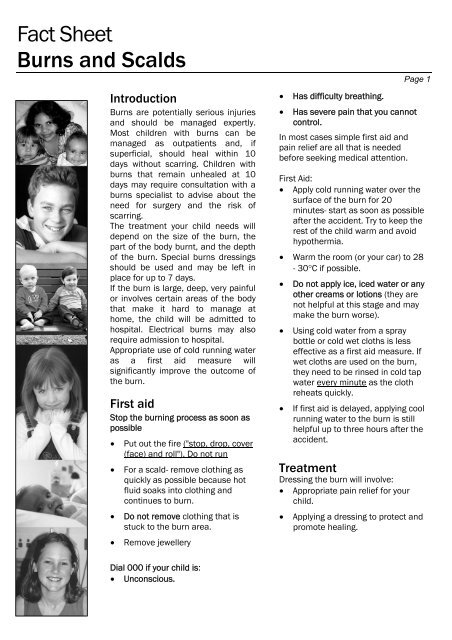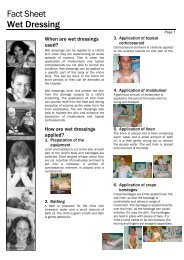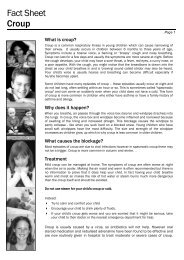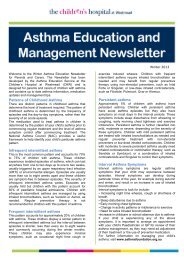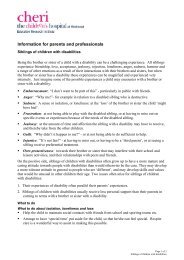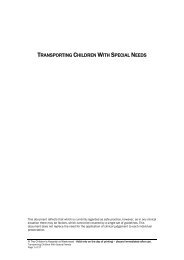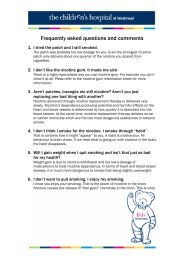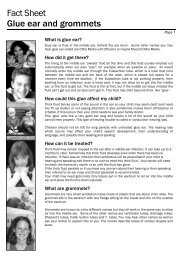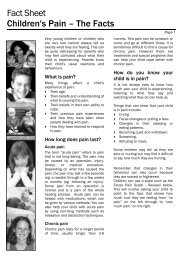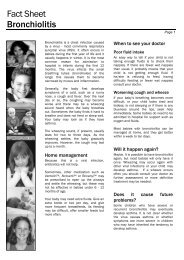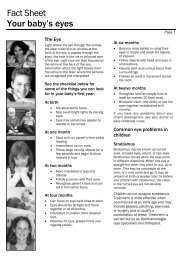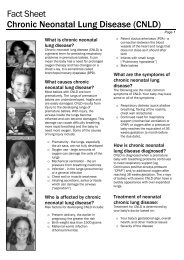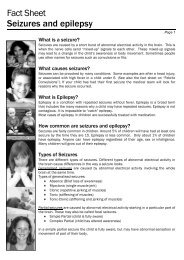Fact Sheet Burns and Scalds - Kids Health @ CHW
Fact Sheet Burns and Scalds - Kids Health @ CHW
Fact Sheet Burns and Scalds - Kids Health @ CHW
Create successful ePaper yourself
Turn your PDF publications into a flip-book with our unique Google optimized e-Paper software.
<strong>Fact</strong> <strong>Sheet</strong><br />
<strong>Burns</strong> <strong>and</strong> <strong>Scalds</strong><br />
xcvxcvxcv<br />
Introduction<br />
<strong>Burns</strong> are potentially serious injuries<br />
<strong>and</strong> should be managed expertly.<br />
Most children with burns can be<br />
managed as outpatients <strong>and</strong>, if<br />
superficial, should heal within 10<br />
days without scarring. Children with<br />
burns that remain unhealed at 10<br />
days may require consultation with a<br />
burns specialist to advise about the<br />
need for surgery <strong>and</strong> the risk of<br />
scarring.<br />
The treatment your child needs will<br />
depend on the size of the burn, the<br />
part of the body burnt, <strong>and</strong> the depth<br />
of the burn. Special burns dressings<br />
should be used <strong>and</strong> may be left in<br />
place for up to 7 days.<br />
If the burn is large, deep, very painful<br />
or involves certain areas of the body<br />
that make it hard to manage at<br />
home, the child will be admitted to<br />
hospital. Electrical burns may also<br />
require admission to hospital.<br />
Appropriate use of cold running water<br />
as a first aid measure will<br />
significantly improve the outcome of<br />
the burn.<br />
First aid<br />
Stop the burning process as soon as<br />
possible<br />
Put out the fire ("stop, drop, cover<br />
(face) <strong>and</strong> roll"). Do not run<br />
For a scald- remove clothing as<br />
quickly as possible because hot<br />
fluid soaks into clothing <strong>and</strong><br />
continues to burn.<br />
Do not remove clothing that is<br />
stuck to the burn area.<br />
Remove jewellery<br />
Dial 000 if your child is:<br />
Unconscious.<br />
Page 1<br />
Has difficulty breathing.<br />
Has severe pain that you cannot<br />
control.<br />
In most cases simple first aid <strong>and</strong><br />
pain relief are all that is needed<br />
before seeking medical attention.<br />
First Aid:<br />
Apply cold running water over the<br />
surface of the burn for 20<br />
minutes- start as soon as possible<br />
after the accident. Try to keep the<br />
rest of the child warm <strong>and</strong> avoid<br />
hypothermia.<br />
Warm the room (or your car) to 28<br />
- 30C if possible.<br />
Do not apply ice, iced water or any<br />
other creams or lotions (they are<br />
not helpful at this stage <strong>and</strong> may<br />
make the burn worse).<br />
Using cold water from a spray<br />
bottle or cold wet cloths is less<br />
effective as a first aid measure. If<br />
wet cloths are used on the burn,<br />
they need to be rinsed in cold tap<br />
water every minute as the cloth<br />
reheats quickly.<br />
If first aid is delayed, applying cool<br />
running water to the burn is still<br />
helpful up to three hours after the<br />
accident.<br />
Treatment<br />
Dressing the burn will involve:<br />
Appropriate pain relief for your<br />
child.<br />
Applying a dressing to protect <strong>and</strong><br />
promote healing.
<strong>Fact</strong> <strong>Sheet</strong><br />
<strong>Burns</strong> <strong>and</strong> <strong>Scalds</strong><br />
xcvxcvxcv<br />
Some dressings need daily<br />
checks, but most are regularly<br />
checked every 3-7 days (it may<br />
take up to 5 days to determine<br />
how deep the burn is)<br />
<strong>Burns</strong> that are unhealed at 10-14<br />
days need to be discussed with a<br />
burns specialist to determine<br />
further treatment <strong>and</strong> assess the<br />
risk of scarring<br />
The type of dressing may change<br />
as the burn heals<br />
You will be given instructions on<br />
how to care for the dressing at<br />
home.<br />
Pain relief<br />
All burns are painful.<br />
Cold water provides excellent pain<br />
relief if used early.<br />
Medicine such as Panadol,<br />
Dymadon, or Tempra can give<br />
good pain relief.<br />
If pain persists, stronger oral pain<br />
relief may be needed. Larger<br />
burns may need pain relief by<br />
injection (if it is thought that the<br />
child will need more than one<br />
injection, admission to hospital is<br />
needed).<br />
Your child may cry for a number of<br />
reasons other than pain (i.e. fear,<br />
anxiety <strong>and</strong> hunger).<br />
Your reassurance will be<br />
comforting to them (listen to their<br />
fears <strong>and</strong> answer their questions<br />
truthfully).<br />
What can go wrong?<br />
(Infection)<br />
Infection is rare.<br />
Page 2<br />
Bring your child back to the hospital<br />
any time of night or day if your child:<br />
Seems unwell or won’t eat or<br />
drink.<br />
Has a temperature over 38.5<br />
degrees Celsius.<br />
The wound begins to smell (some<br />
yellowish, silvery brown ooze is<br />
expected, depending on which<br />
dressing is used).<br />
There is pain in the burn area.<br />
The dressing falls off or comes<br />
loose or you notice redness<br />
spreading out from the initial<br />
injury.<br />
It is important to avoid your child<br />
coming into contact with anyone who<br />
has or is developing cold sores on the<br />
lips, or has chicken pox (unless your<br />
child has had chicken pox or has<br />
been vaccinated against it).<br />
Diet<br />
It is important your child eats healthy<br />
foods so that the body has the right<br />
nutrients it needs to heal.<br />
Activity<br />
Keep dressings clean <strong>and</strong> dry.<br />
Your child should engage in normal<br />
play, both with you <strong>and</strong> other<br />
children.<br />
Accidents which cause pain <strong>and</strong><br />
require the child to go to hospital can<br />
make them feel insecure so extra<br />
cuddles are needed. <strong>Kids</strong> often feel<br />
guilty because they have caused so<br />
much trouble. Be patient but<br />
continue to have the same important<br />
rules at home even if the details are<br />
more relaxed.
<strong>Fact</strong> <strong>Sheet</strong><br />
<strong>Burns</strong> <strong>and</strong> <strong>Scalds</strong><br />
xcvxcvxcv<br />
Will my child need an<br />
operation?<br />
In the first few days following a burn,<br />
it is often not possible to tell how<br />
deep the injury is, how long it will take<br />
to heal or if there will be scarring.<br />
Any burn that heals within 10-14 days<br />
is unlikely to scar <strong>and</strong> will probably<br />
not require an operation. However, if<br />
most or all of the skin in the area of<br />
the burn is destroyed, healing is slow,<br />
the risk of infection is increased, <strong>and</strong><br />
there is likely to be scarring, so<br />
healing may be improved by an<br />
operation. In this operation, the dead<br />
skin is removed <strong>and</strong> the area is then<br />
covered with a thin layer of skin taken<br />
from another part of the body (a skin<br />
graft area). It may be up to 10-14<br />
days after the injury before a decision<br />
about grafting can be made. If it is<br />
needed the operation will be fully<br />
explained to you.<br />
Scarring<br />
If the burn has taken longer than 2 to<br />
3 weeks to heal or has required a<br />
skin graft, scarring is likely. With<br />
time, burns scars may become<br />
raised, red, itchy <strong>and</strong> painful <strong>and</strong> may<br />
cause limitation of movement if over<br />
a joint. Once the burn is healed,<br />
treatment of the scar is crucial, to<br />
reduce these problems <strong>and</strong> improve<br />
as much as possible the long term<br />
appearance of the affected skin. The<br />
doctors <strong>and</strong> physiotherapists will<br />
supervise scar treatment <strong>and</strong><br />
management.<br />
This fact sheet is for education purposes only.<br />
Please consult with your doctor or other health professional<br />
to make sure this information is right for your child. This document was reviewed on 16 th March 2011<br />
www.chw.edu.au www.sch.edu.au www.kaleidoscope.org.au<br />
© The Children’s Hospital at Westmead, Sydney Children’s Hospital, R<strong>and</strong>wick & Kaleidoscope * Hunter Children’s <strong>Health</strong> Network 2011<br />
Page 3<br />
After care<br />
All new <strong>and</strong> healed burns are very<br />
sensitive to sunburn.<br />
Keep burn areas covered <strong>and</strong><br />
apply <strong>Fact</strong>or 30+ sunscreen.<br />
If the burn has healed quickly<br />
(meaning that it has not been very<br />
deep) it will become less sensitive<br />
after six to twelve months.<br />
New skin needs to be kept<br />
healthy by regular use of<br />
moisturising cream (use glycerine<br />
<strong>and</strong> sorbolene cream at least<br />
twice a day).<br />
Deep burns will need moisturiser<br />
more frequently, for a longer<br />
period of time.<br />
Remember<br />
First aid –first stop the burning<br />
process, remove hot clothes <strong>and</strong><br />
jewellery <strong>and</strong> apply tap water for<br />
20 minutes<br />
Follow the treatment <strong>and</strong> advice<br />
of your doctor to achieve the best<br />
possible outcome in terms of<br />
appearance <strong>and</strong> function for your<br />
child<br />
With good care, most burns heal<br />
with minimal scarring.


